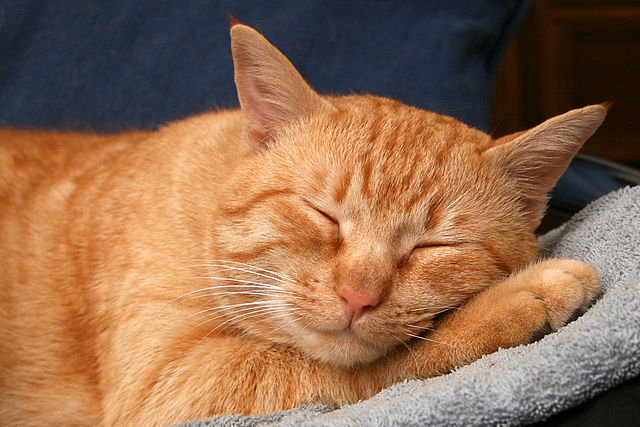You Won't Believe How Animals Sleep - Part 1
Sleeping kitty.
(http://en.wikipedia.org/wiki/File:RedCat_8727.jpg)
Ahhh... Sleep.
That peaceful, restful, bliss. I don't have to tell you how nice sleep feels. You do it yourself. Just about everybody does. Not only humans, but pretty much all animals. Something resembling sleep has been documented in almost all animals, for birds to bees. If you are, like us, a wannabe scientist, you may have asked what should have been the dumbest question of them all. "Why do we sleep?". We have a few plausible theories, but first, let's look around us for a bit.
The first reality check we have to pass, is that we are a bit dumbfounded here.
All humans, since the dawn of the species, have spent almost a third of their lives in an unconcious state, sometimes vividly hallucinating (dreaming)
Humans aren't the only ones to behave in this curious way. All mammals do it, so do birds, and bees, and cockroaches, locusts, crayfish. Also scorpions, reptiles and even insects. Every tested animal showed some variant of the process of sleep, and still, we are not much closer to knowing why.
In fact, after studying sleep in animals, we seem to have ended up with more questions than answers.
To get a handle on what is going on during sleep, we have to go to the control room. The mother lode, the source of all behaviours and actions - the brain. With medical procedures now as advanced as they are, we can just drill a hole into an animal's skull, stick some electrodes in there, and watch what happens as it goes about it's activities, including sleeping. [1]
A dolphin, with blowhole visible. That is the quivalent of a breathing hole
(http://en.wikipedia.org/wiki/Dolphin#mediaviewer/File:Bottlenose_Dolphin_KSC04pd0178.jpg)
Now, keeping that in mind, consider the situation of a dolphin. It lives in the water, but is a air-breathing mammal, so it has to periodically come up to the surface to respire. They are also concious breathers, which means they have to conciously come up to the surface to breathe, every few minutes. Now also take into consideration the fact that a dolphin needs to sleep, often 8 hours a day. When you look at those two together, there is an obvious problem.
How does a does it stay afloat and get the air it needs to breathe while it sleeps.
Nature, as usual, when faced with difficult problems, often comes up with genius, often borderline crazy solutions.
How did it solve the problem of breathing while the brain needed to rest? Pretty simply.
It slept half a brain at a time.
Let me repeat that.
It sleeps half a brain at a time.
If you were as shocked as I was when I first learned this, you need to take a minute to think about this. This is known as uni-hermispheric sleep. This is how the dolphin solves the problem of breathing while simultaneously allowing its brain, or at least a part of it, to rest.
Now from there outside, nothing is apparant, but, if you stick electrodes into it's skull, its clear what the dolphin brain is doing.
The brainwaves of a patient when awake (highlighted in red) and when they are sleeping.
(http://en.wikipedia.org/wiki/File:Sleep_EEG_Stage_4.jpg)
One half of their brain, is exhibiting slow wave sleep (second half of the image), while the other hemisphere is representative of the short high-frequency waves of wakefulness.
So we've seen that all animals need to sleep, and even when they're in conditions that don't make it easy to do so, nature finds a way to circumvent the problem, and get that sleep.
Next up, in Part 2, where ducks come into the pictures, what it means for humans, and why you can't get a good first night's sleep in a hotel room.
Additional Information
This article was inspired by a segment on the radio show Radiolab (http://www.radiolab.org/story/91528-sleep/)
[1] This may seem like a horribly cruel thing to do, but in reality, these procedures aren't too invasive at all. With a few minutes of the anaesthetic wearing off, animals are back to their routine activities of eating, jumping and lazing around.
Further information about uni-hermispheric sleep:
http://en.wikipedia.org/wiki/Unihemispheric_slow-wave_sleep
Lapierre, Jennifer L.; Kosenko, Peter O.; Lyamin, Oleg I.; Kodama, Tohru; Mukhametov, Lev M.; Siegel, Jerome M. (2007). "Cortical Acetylcholine Release Is Lateralized during Asymmetrical Slow-Wave Sleep in Northern Fur Seals". The Journal of Neuroscience 27 (44): 11999–12006.
Rattenbourg, Neils C.; Amlaner, C.J.; Lima, S.L. (2000). "Behavioral, neurophysiological and evolutionary perspectives on unihemispheric sleep". Neuroscience and Biobehavioral Reviews 24 (8): 817–842. doi:10.1016/S0149-7634(00)00039-7. PMID 11118608.



